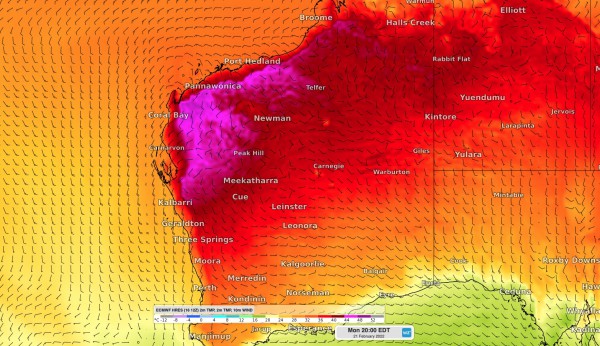An extremely hot and dry airmass will spread over northwestern Australia later this week, causing temperatures to hit the high-forties in some areas.
A stubborn high-pressure system moving slowing into the Great Australian Bight will direct an extremely hot and dry airmass over northwestern WA during the next several days.
This prolonged burst of hot air is set to generate an extreme heat wave across some northern and central districts of WA.
Temperatures will hit the high 30’s to mid 40’s each day in the next week in these districts, and may hit the high-40’s in some areas, as prevailing easterlies provide no relief from the persistent heat.
The heat is set to peak on Sunday and Monday with temperatures tipped to hit the mid-to-high 40’s. The map below shows the hot airmass being driven over northwestern WA on Sunday and Monday.
Images: Forecast surface air temperature and wind speed/direction on Sunday (top) and Monday (bottom) afternoons, according to the ECMWF model.
This hot and dry air will combine with strong and gusty winds at times, resulting in very high to severe fire danger ratings over a number of districts in the coming days.
A fire weather warning was issued on Thursday for the Central West and Gascoyne districts, while on Friday the severe fire danger will spread to the East Pilbara, Lower West Coast, North Interior and Central West districts.
Fire danger is likely to remain elevated through the weekend and into the start of next week as well as the hot air mass lingers over the state’s west and north.
This heatwave will also cause Perth to reach the mid-to-high 30’s for the rest of this week and early next week, peaking on Friday at around 38ºC. For more information on Weatherzone’s extreme heat and fire danger forecasting, please contact us at apac.sales@dtn.com.








